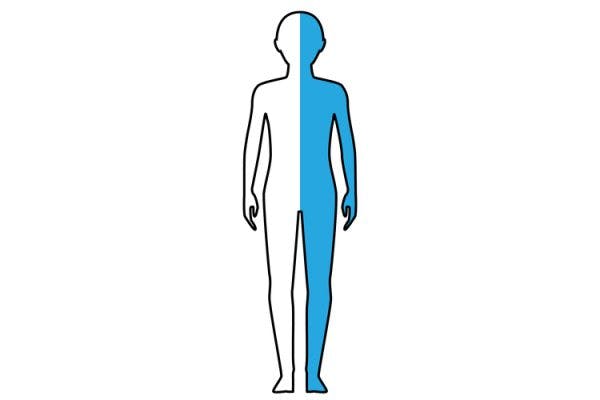Seizures after a stroke occur because of changes in electrical activity within the brain. However, just because you’ve had a stroke does not mean you’ll experience a seizure; and just because you’ve had a seizure does not mean you have epilepsy.
Many factors, including the severity and location of a stroke, can influence one’s likelihood of having a seizure. In this article we will discuss what leads to seizures after stroke, risk factors, and different types of seizures. We will also review common symptoms and what to do if someone is experiencing a seizure.
You can use the jump links below to help navigate through the article:
What Causes Seizures After Stroke?
A stroke is a neurological injury caused by either a blocked or ruptured artery in the brain. When a stroke occurs, an area of the brain is deprived of oxygen-rich blood, which can lead to tissue damage and other changes in the brain.
A seizure is caused by a sudden burst of disorganized electrical activity in the brain. When a stroke causes tissue damage in the brain, it can disrupt the flow of electrical activity between nerve cells and cause a seizure.
Outwardly, seizures can present with a variety of signs or symptoms. Signs of a seizure occurring can include altered consciousness or awareness, cognitive or emotional changes (like confusion or anxiety), staring blankly, and involuntary convulsions or jerking movements of the arms and legs.
Seizures generally last from seconds to several minutes and can be alarming for both the individual and their caregiver. It is also important to note that a seizure can occur with or without loss of consciousness.
Changes that occur in the brain following a stroke may make the brain more susceptible to seizures. These changes can include:
- Decreased blood flow
- Low cerebral metabolic rate for oxygen
- Changes in neuron excitability
- Increased blood-brain barrier permeability
- Scar tissue formation
While a stroke increases one’s risk of having a seizure, not all strokes are equal. The following section will discuss why some strokes are more likely to cause a seizure than others.
Are Seizures Common After Stroke?
A recent meta-analysis of 102,008 stroke survivors suggests that about 7% of individuals experience seizures after stroke. Therefore, it’s essential to understand the various factors that may contribute to increased seizure risk.
Some risk factors for seizures after stroke include:
- Type of stroke. Seizures are more common following a hemorrhagic stroke (a stroke caused by a burst artery) than an ischemic stroke (a stroke caused by a blocked artery).
- Severity of stroke. The more severe the stroke, the greater the area of tissue damage present in the brain. This can increase the likelihood of having a seizure due to disruption of the brain’s electrical activity.
- Location of stroke. Seizures are more likely to occur when the stroke involves multiple lobes of the brain rather than a single location. Individuals who experience ischemic stroke in the cerebral cortex and hippocampus are at greater risk for seizures. Hemorrhagic stroke, on the other hand, is more likely to cause seizures when the middle cerebral artery is involved.
- Age. This population-based cohort observed that seizures occurred within 24 hours of the stroke in 58% of children. Another recent study found that survivors under the age of 65 are 65% more likely to experience seizures after stroke. Although seizures may be more common in younger populations, stroke is also the most common cause of seizures in the elderly.
It is important to note that the onset of seizures after stroke may not be related to stroke at all. For example, some individuals carry a genetic predisposition to seizures, regardless of whether they’ve had a stroke.
Common Symptoms of Seizures After Stroke
Seizures can be classified into two main subcategories. A variety of symptoms make up the two subcategories of seizures, called focal onset seizures and generalized onset seizures.
Focal onset seizures, called partial seizures, occur in one smaller area of the brain. This type of seizure may cause the individual to fall, exhibit muscle twitching, or cause changes in sensation such as distorted smell or taste. Someone experiencing a focal seizure may also appear dazed, confused, and unresponsive to questions.
Generalized onset seizures affect both hemispheres of the brain. Individuals experiencing generalized onset seizures often present with larger global symptoms including muscle spasms or flailing, loss of consciousness, verbal sounds, rhythmic muscle movements, stiffening, and loss of bladder control.
Generalized onset seizures can also cause the individual to appear absent. This can consist of rapid eye movements or blank staring without reaction to the environment.
Seizures can present with a wide variety of more specific symptom types (tonic, atonic, myotonic, and clonic) and may look different for every individual. It is important to educate yourself on common seizure symptoms in order to stay safe and get the help you need.
Timeline and Types of Seizures After Stroke
Generally, a seizure is most likely to occur within the first 24 hours after the onset of stroke. However, it is also common for seizures to occur within the first few weeks after stroke.
Often, there are two peaks in seizure occurrence after stroke. The first usually occurs within the first day while the second occurs sometime between 6-12 months. These two main seizure timelines can be classified as early-onset and late-onset seizures. The underlying cause and potential to cause additional seizures are what differentiate them.
Generally, a seizure that occurs within the first week or two after a stroke is considered an early-onset seizure. Oftentimes, early-onset seizures are provoked seizures. This means that they usually occur immediately after a stroke but can be due to other factors, such as severe infection, high fever, or kidney failure.
In contrast, late-onset seizures occur at least 1-2 weeks after stroke and peak 6 to 12 months after stroke. This type of post-stroke seizure is generally considered unprovoked. This means it is not caused by anything external, such as an infection. Unprovoked seizures imply more than a 60% risk of seizure recurrence.
Will a Seizure After Stroke Lead to Post-Stroke Epilepsy?
Although a single unprovoked seizure is a common occurrence following stroke, multiple unprovoked seizures are the main criteria for a diagnosis of post-stroke epilepsy. It’s reported that strokes account for about 11% of all adult epilepsy cases and 45% of epilepsy cases in individuals over 60 years of age.
Post-stroke epilepsy is a neurological disorder characterized by recurrent seizures that are not associated with a specific cause. Having a single seizure does not necessarily mean that you will develop post-stroke epilepsy. However, if someone has two or more unprovoked seizures after a stroke, they are likely to be diagnosed with post-stroke epilepsy.
If you experience recurring seizures after stroke, be sure to seek emergency medical attention. If not addressed, seizures after stroke can be dangerous and lead to poor outcomes. Detection and official diagnosis of post-stroke epilepsy will help your medical team provide appropriate treatment to maximize your health, safety, and quality of life.
Can Post-Stroke Epilepsy Be Treated?
Generally, treatment for post-stroke epilepsy consists of anti-epileptic drugs, called AEDs or anticonvulsants. Other treatment options include vagus nerve stimulation or, in severe cases, surgery.
There are several AEDs that can help reduce seizure frequency and severity to get your post-stroke epilepsy under control. These medications work by altering chemicals in the brain to reduce the excessive electrical activity that causes seizures to occur. However, they may not be ideal for all individuals as they have various side effects, including feelings of sedation.
Doctors may also treat seizures after stroke using a vagus nerve stimulator. This device sends electrical impulses to the brain via the vagus nerve, providing electrical input to targeted areas in order to prevent seizures. Although implantation of a vagus nerve stimulator is somewhat invasive, this is an effective treatment with few documented adverse effects.
If AEDs or vagus nerve stimulation prove ineffective, a surgical intervention called thermal ablation may help. Thermal ablation uses laser technology to remove the hyperactive brain cells that cause seizures to occur. Surgeons may need to perform more invasive procedures if the brain has extensive damage or scar tissue.
Your doctor will be able to discuss your treatment options and help you decide on a plan to address your specific needs and symptoms. Whichever treatment you choose, it’s always a good idea to set up a Seizure Response Plan with your family and friends. Being prepared with a response plan will help others care for you effectively if you have another seizure. The following section will provide more tips for this.
What To Do When Someone Is Having a Seizure
Watching someone experience a seizure can be a frightening experience. Individuals may suddenly become unresponsive and have uncontrollable body movements or irregular eye movements. Knowing how to properly help someone who is having a seizure after stroke is critical for their health and safety.
If you’re a stroke survivor, share the following information with your friends and family so they know how to help if you have a seizure. When someone is experiencing a seizure:
- Get them to the ground safely. If the person is standing or in a chair, move them to the floor gently. This will prevent them from falling and acquiring a serious injury. If they are laying down in bed, make sure they are not too close to the edge.
- DO NOT hold the person down. When someone is having a seizure, stopping their movement will not stop the seizure. The seizure is happening in their brain, not their body. Holding them still will only hurt them and possibly yourself as well.
- Get them into a recovery position. Follow the steps from the Epilepsy Society to safely roll the person to their side and get them into a “recovery position.” This will help them breathe and avoid choking.
- Move nearby objects away. Since a person cannot control their body during a seizure, they are unaware of their environment and cannot avoid sharp objects around them. Keep them safe by moving anything dangerous away and by removing other articles that may cause harm, such as glasses or anything around the neck.
- DO NOT put anything in the person’s mouth. Individuals cannot control their jaw movements during a seizure, so putting something in their mouth is a major choking hazard and can cause serious damage to their mouth.
- Time the seizure. If a seizure lasts more than 5 minutes, call 911 immediately.
- Speak calmly and offer reassurance. After a seizure ends, the person will likely feel confused, anxious, and possibly embarrassed. Comfort them and let them know everything will be okay.
While seizures normally resolve on their own within 30 seconds to 2 minutes, it’s also important to know when a seizure requires emergency medical attention.
Emergency Guidelines for Seizure After Stroke
Guidelines from the CDC state that is necessary to call for emergency help if the individual:
- Has a seizure that lasts longer than 5 minutes
- Experiences multiple seizures back-to-back
- Suffers an injury during the seizure or has a seizure in water
- Appears to be choking or having difficulty breathing
- Is having a seizure for the first time
- Is pregnant or has other health conditions such as heart disease or diabetes
Seizures After Stroke: Key Points
Changes in the brain after stroke (as well as the type, severity, and location of the stroke) can increase one’s risk of having a seizure. Most seizures occur within the first 24 hours after a stroke begins, but they can also happen weeks, months, or even years later.
Depending on how long after stroke your seizure occurs, you may be at risk of having recurring seizures and developing post-stroke epilepsy. Fortunately, anti-epileptic drugs, vagus nerve stimulation, and surgery can help effectively treat epilepsy after stroke.
We hope this article helped you understand the implications of seizures after stroke and what to do if one occurs. It’s important for everyone to be knowledgeable about seizure management, so be sure to share this vital information with your loved ones.










